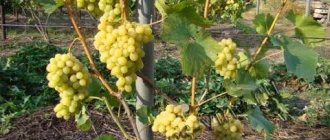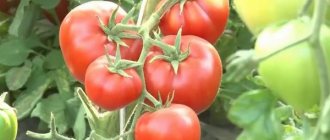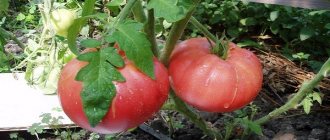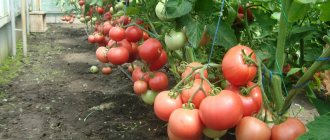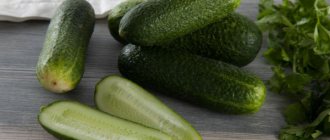Over thousands of years, viticulture has not lost its popularity. When it seems that a better variety cannot be wished for, breeders do the impossible. And a new unique variety is born. Grapes cease to be just berries, but turn into the brainchild of a master. The fruits of successful crossing, warmed by the generous southern sun, delight the eye with their beauty and abundant harvest. One of the best varieties today is the Ruta grape. It has undeniable advantages and a unique bouquet. Even the most experienced gardener will be proud of these grapes.
Description of Ruta grapes
An excellent table variety, it has absorbed all the best from Talisman and Radiant raisins. The fruits ripen quickly (within 95-100 days). The berries can remain on the vine for a long time without compromising their taste or presentation. Therefore, Ruta grapes are specially planted for sale.
The more fertile the soil, the stronger the vine grows. For example, on black soil its height can reach 4 m. This is especially true for bushes that were obtained as a result of cuttings. The number of stepsons is relatively small, so the plant can do without rationing.
The berries of the Ruta grape are quite large and oval. They weigh from 10 to 15 g. Their color varies from crimson to amber (depending on the amount of sun). The skin is tender, but does not crack during transportation. The pulp is juicy and sweet. There is always a slight sourness and nutmeg notes. You can also detect a slight cherry flavor. Luxurious bunches weigh from 500 g to 800 g. Experienced gardeners claim that this is not the limit.
Attention! The ripe fruits of the Ruta grape make very tasty compotes and juices, as well as homemade wine.
Pros and cons of the Ruta grape variety
There are many descriptions, photos of the variety, and reviews about Ruta grapes. But they all have both positive and negative characteristics.
The undeniable advantages include the following:
- grapes have practically no pea effect;
- the bunches can be stored for a long time and safely transported even over long distances (the presentation does not suffer from this);
- Ruta grape roots quickly adapt to different types of soil;
- bushes reproduce well;
- this variety is known for its average but stable yield;
- bushes are resistant to most diseases.
You will also have to face some disadvantages:
- for successful pollination of Ruta grapes, you need to plant bushes of other varieties nearby that will bloom at the same time (this is due to the fact that Ruta has exclusively female flowers);
- not the highest frost resistance (up to - 21 ° C and then only with shelter);
- strongly growing bushes require large areas for planting (support is necessary for harmonious growth and ripening of fruits);
- high risk of phylloxera infection.
Characteristic
Sweet, beautiful berries, a wonderful appearance of a powerful and unpretentious vine, resistance to fungal diseases and indifference to wasp attacks make Ruta grapes a welcome guest in every garden in the southern regions of the country.
Fruiting
The hybrid form of Ruta grapes is gaining popularity with its unique taste and early ripening period - 90-100 days.
- From the beginning of August you can enjoy beautiful pink berries with delicate pulp and rich taste;
- The fruits hang on the bunch until the end of September, retaining their pleasant taste and without losing berries. Thanks to the dense skin, the berries retain their presentation for a long time, without cracks or signs of rot;
- The yield of Ruta grapes, as gardeners note in the descriptions of the variety, is average. But the stability of fruiting attracts;
- You don’t even have to wait long for the first berries. Signal clusters appear already in the second year after planting.
Features of the vine
The vigor of the vine and the female type of flower cause incomplete pollination if other varieties do not grow nearby that bloom at the same time as Rue. For example, a good pollinator is the Arcadia grape, which is by no means rare in the areas. But the berries are all ripening, Ruta grapes have no problems with peas.
- A powerful grape bush must be provided with a large area for sufficient nutrition;
- When planting Ruta grapes, the gardener, having read the description of the variety, must install strong supports so that they can carry a heavy bush;
- The variety is well suited for planting near arches;
- Rue cuttings take root well;
- This grape variety has good compatibility with all rootstocks.
Genetic properties
The heat-loving variety Ruta can grow without problems in the Krasnodar region. The grapes have low frost resistance - can withstand only -21 degrees. Gardeners should take care of shelters for the winter in advance.
The Ruta variety is resistant to characteristic grape diseases, including diplodia. According to the description of the author of the variety, resistance to mildew is estimated at 3.5-4 points, 3 points each for gray rot and oidium.
Optimal growing conditions
This variety is one of the unpretentious ones. It can grow in different regions, but it has proven itself best in the south. Ruta grapes prefer a mild and warm climate and do not tolerate strong cold winds. In winter, it is better to cover the bushes. An air temperature below - 21 ° C will destroy the plant.
Do not overload the vine. A depleted plant will not produce a good harvest. One of the signs of grape health is the annual increase in the number of fruits by at least doubling. Another condition for good growth is sunny summer. The leaves absorb the beneficial rays, saturating the grapes with everything they need.
Attention! Additionally, it is worth taking care of ventilation of the roots. To do this, the soil is kept loose.
conclusions
- The “ruta” variety is considered one of the best pink varieties of very early ripening.
- The grapes are not picky in care and respond well to watering, pruning, fertilizing and mulching.
- The variety is relatively frost-resistant, but still requires insulation in latitudes with difficult weather conditions.
- Ruta grapes have a lot of useful properties and look good compared to other early ripening pink varieties.
You might be interested in learning about other table varieties
Planting and caring for Ruta grapes
Ruta grapes are not very demanding on conditions. But still, in order to have a healthy plant and regularly receive high-quality fruits, some recommendations should be followed.
Selection and preparation of a landing site
For Ruta grapes, soil composition is not as important as for other varieties. But the best option would be nutritious black soil. The area should be well lit. It is better to plant grapes near tall buildings. They will become a shield against cold wind and draft. The Ruta variety needs space. The bushes grow quickly and will steal light from other plants. When planting, it is better to maintain a distance of at least 3 m from the nearest bushes or trees. It is necessary to immediately arrange trellises.
You need to prepare the place for planting Ruta grapes in advance. It is most convenient to do this in the summer. The soil is dug up, all weeds are removed and fertilizers are applied in the usual dosage.
Landing rules
It is important to decide on the timing. If Ruta grape seedlings were purchased in the fall, it is better to immediately dig them in and cover them before the cold weather. But it is advisable to plant grapes in the spring, when you can not be afraid of frost. The ideal time is the second half of April or May.
It is necessary to dig a hole (approximately 7070 cm or more). If we are talking about planting several bushes of Ruta grapes at once, the trench method will be more convenient. Make a landing ditch at least 60 cm deep. A good drainage layer of pebbles or crushed stone (about 15 cm) is poured onto the bottom. Here a special pipe is installed vertically. It will allow you to water the grapes directly at the roots at first. The hole is filled with earth mixed with various fertilizers until the middle: humus (a couple of buckets), nitroammophoska (1/2 kg) + ash (2 l). Next, the seedling is placed. On top there is clean fertile soil without fertilizing.
When a Ruta grape bush is planted in the spring, it is important that there are no more than two buds on the surface. The roots should come into contact only with clean soil (no fertilizers). Now you need to water the grapes thoroughly and mulch the soil.
Watering and fertilizing
You need to moisten the soil immediately after planting. After this, mulch it. Next, watering the Ruta grapes is carried out at certain intervals. During tying, 7 days after pruning and when the Ruta grape seedlings become a little more than 30 cm. The subsequent application of moisture is carried out a week before flowering, when the clusters form, and about a month before harvesting. Before wintering, do the last watering. It is called moisture-saturating. This is especially true in dry autumn.
Three feedings are applied per season. One at planting (potassium fertilizer and superphosphate with nitrogen), the second a couple of weeks before flowering (litter mixed with phosphorus), and the third when ripe berries appear (nitrogen with superphosphate again). Mineral components can be alternated with organic ones by adding solutions based on manure, ash or bird droppings.
Trimming and shaping
If this procedure is carried out in the spring, then approximately 60 eyes are left on the Ruta grape bushes. The thinner the vine, the more actively clusters are formed on it. Excess shoots are cut off in the summer, and in the fall the vines are pruned to 8-10 buds.
Preparing for winter
Shelter is required almost everywhere. The only exceptions are the southernmost regions. Ruta grape vines are removed from their supports and laid out on the ground. You should get some kind of bunches. Spruce or pine spruce branches are used to cover them. It is wise to place rodent control products around. In the central regions, spruce branches are reinforced with spandbond or roofing felt.
Productivity
Ruta grape shoots ripen quite well, albeit unevenly. With correct and timely pruning, the proportion of consistently fruiting vines reaches 80%. On average, up to 12 kg of ripe berries can be harvested from one Ruta grape bush.
How to grow crops correctly
There are several recommendations that will help you grow the Rutu variety correctly.
Preparing the landing site
Before planting, it is necessary to first prepare the seat. First, the area is carefully dug up and cleared of weeds. Then mineral and organic fertilizers are added to the soil, which promote the growth of grape bushes.
Landing technique
Planting seedlings is carried out in several stages:
- Creating a planting hole. To do this, a square hole is dug, the length and width of which is forty centimeters.
- Filling the pit. The bottom of the dug hole is covered with a thin layer of soil mixed with mineral fertilizers and water.
- Planting. After filling the planting hole, carefully place the seedling in it and sprinkle it with soil.
Diseases and pests
Ruta is a fairly resistant grape variety. But still susceptible to some diseases.
Most often it is affected by:
- Gray rot. The grapes, berries, and branches of Rue become covered with an unpleasant white coating.
- Anthracnose. Infection of fungal origin. It affects leaves, shoots, and then fruits.
- Mildew. This is a virus that spreads to the green parts of the branches and reaches the berries. Shoots and leaves wither and die.
- Black spot. The vine changes color and rot appears on it in the form of growths.
- Powdery mildew. Leads to the fact that the bush dies off in whole fragments.
You can fight fungi on Ruta grapes with the help of fungicides (Ridomila, Horusa, Akrobata, Tiovita, etc.). They are used already at the stage of the disease and as prophylactic agents. Infected branches are removed, and cut sites are treated with growth stimulants.
Of the harmful insects you should be most wary of:
- Leaf rollers. Caterpillars appear on the leaves and clusters and feed on the berries.
- Phylloxera (grape aphid). It completely destroys the roots. The source can be irrigation water, or the pest can be carried in by the wind.
- Ticks. They suck out the juices from the leaves and branches, causing the plant to dry out.
- Cicadas. Dangerous carriers of viruses.
- Pads. Acts like ticks, but also spreads infection.
- Zlatki. These are beetles that gnaw through shoots and make passages in them. As a result of this, rot is formed.
To get rid of parasites, you need to use fumigants. The most effective of them are “Aktellik”, “Neoron”, “Confidor”, “Fufan”. Frequent inspection of the bushes will help to identify insects in time. If you follow the rules of watering and fertilize the grapes in a timely manner, you don’t have to worry about diseases. A good preventative measure would be decoctions based on onion and dill peels.
Reviews of Ruta grapes
Valery Mikhailovich Kolomoisky, 53 years old, Samara
This is the first time I have planted such grapes. What attracted me was that Ruta matures early. Our winters are mild, so the bush survived the cold without loss. Pests and diseases were also not a problem. The harvest, of course, is not very large. But I was warned in advance that this was normal. I didn’t intend to sell it, but there’s enough to enjoy. I was very pleased with the taste. Sweet, but the acid is almost not felt. Next year I'll take up wine.
Antonina Valerievna Chaika, 45 years old, Ufa
We purchased seedlings of this grape for my aunt. She loves all the new gardening items. I haven’t tried the Ruta variety yet. The seedlings took root with a bang. The bush is growing a lot, you have to control it. But my aunt was rich in the first berries by the end of July. We'll see what happens next year, but so far so good.
Sergey Nikolaevich Belchin, 60 years old, Perm
Rue is an interesting variety, but not without its challenges. You need to constantly monitor growth, otherwise neighboring bushes may suffer. Berries sometimes become overripe, and you also need an eye. But all these shortcomings are not so terrible. Everyone loves care and concern. But the fruits are tasty and beautiful, and are stored for a long time. So I'm happy with the variety.
